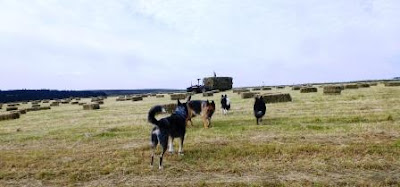The last day of July ... a drop in temperature ... no blue skies, a lot of cloud cover ... rain!
Acres of turned hay in one of my favourite fields laid waste, not even baled for silage, yet.
This belongs to the farm where Ffin was born and were the baler needed spares from Germany at a phenomenal cost of thousands of pounds to mend much needed machinery.
It's a sad sight.
Our local farmers have been working from early morning until dusk and in some cases in the hours of near darkness. Today was also market day, so they've also been busy getting lambs and ewes for today's sales. Luckily at the moment the prices are fairly reasonable but ... not much margin of profit when compared the the long hours and hard graft required for those working with livestock. One farmer was too busy elsewhere to get his silage bales back on the farm and so the silage bales were left on the field for another day.
One of the reasons that our farming folk like to get these huge bales safely stored on the farm, is that some pranksters find it amusing to set them off, rolling down hill. Not only is this a dangerous thing to do, it also means that some of these bales end up in deep ravines, this being hill farming country and end up beyond the ability to recover them. These bales weigh at least 250 kg's and have to be handled by sturdy machinery, usually a tractor with forks, they end up in places a tractor can't access, so they go to waste, rotting away when they could have supplied so many sheep or cattle with winter fodder. Not funny!
An important nitrogen fixing plant and an important addition in a well balanced variety of grasses and flowering plants in a hay crop is the insect attracting red clover
<<< and this year I have found some of the biggest flowers I have ever seen. All that wet weather induced some lush growth. To give you an idea of how large the flowers were ...
I put one of the clover heads on my mobile phone. The sad thing was that when I took this photo ten days ago, it was ... raining!
That meant that very few butterflies and bees were out busily pollinating. In the hay crop, most of the flowering species were past their best, even though the grasses were taller than normal which for some, meant a heavier yield per acre than normal.
Another sight just over ten days ago, was my first sighting of a Fox moth caterpillar, earlier than usual. Last year I saw literally hundreds of these on the moorland, they were everywhere and what beautiful creatures they are, yet the adult moth with a the Latin name Macrothylacia rubi is very unauspicious looking creature.
Yesterday ... I showed you a cocoon on a moorland rush ... I've yet to identify what it is but inside is a black, inch long chrysalis. Rushes are invasive plants.
This is the type of a most rampant species >>>
to be found on the commons. It spreads amazingly and overtakes good grazing with it's thick growth, mostly inedible to the grazing sheep, except when very young and less tough. In the flatter areas, it can be harvested and baled as winter bedding for cattle, as can the bracken, another invasive plant. It was on one of the stems of these that yesterday I found that cocoon, which on closer inspection has a chrysalis inside. Belonging to what, I don't yet know, but hopefully I may get some answers to that little enigma in the weeks ahead. There is another species of rush too, that is shorter and starts with a wine glass shaped growth.
One flowers half way up the stem and each of these flowering heads contains about 150 seeds. (I know I counted them) The other, less tall rush on the left, flowers on a single stem, producing about 5o seeds. Young plants, spread out on a round, which reminds me of sprigs of rosemary in focaccia bread. Apparently the Juncus family are hard to identify ... any one out there who can help? Meanwhile I will leave you with this, a close up of the wonderfully attractive seed heads ...
It makes a change from waffling on about hay!





















































